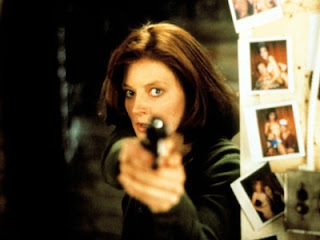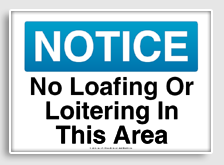
The opening shot of the scene is a silhouette of tree. There is no camera movement, and there is heavy mist in the background, limiting the audiences view of what is lurking beyond the tree; already creating a feeling of suspense and mystery. It is a low angle shot, making the audience feel weak and vulnerable. The sound consists of bird noises, and a non-diegetic soundtrack with a violin, and a chello creating lower, suspense building notes. The titles appear in the middle of the screen dubbed over the opening shot. The lettering is a black 'block' style with a white outline, in-keeping with the FBI theme that runs through the opening sequence. 'Jodie Foster' is the first name that appears, as she is the main star of the film. The camera then, still in one continuous shot, pans down and to the left deeper into the forest from the tree, creating a high angle establishing shot. A few other names of the main stars appear on screen before the film name appears. The camera then settles on Clarice (Jodie) in the distance, working her way up through the forest towards the camera. As she reaches the top, we can hear that she is out of breath, the camera retracts slightly as she pauses and looks around, before running out of shot to the right. Actors names then appear on the screen three at a time, signify that they are lower in the 'pecking order' of stars. As this happens, the camera follows Clarice from a distance, creating a long tracking shot and giving the impression she is running away, although at this point it's quite clear she's doing an assault course. The shot then cuts to close up of her face as she runs, then zooms out slightly into a mid shot of her head and shoulders as she runs, still with the opening music dubbed over. The shot then again cuts, this time to a side angle mid shot from her rights hand side, the camera still moving with her, as she runs through the trees. This way this is shot from behind the trees makes it look quite voyeuristic. The shot then cuts to a close up of her feet as she's running, with the crunching of the leaves underfoot apparent in the sound. As with all the edits in this sequence, the shot is formed from a simple cut, rather than using fades or other effects. More actors names appear on the screen again - but the fact that no actors names appeared during the side angle shot may suggest that this was of greater importance than other shots. The camera then cuts again to a side shot of her face (close up), and again then a tracking shot behind her. She then climbs over a scramble net, and the camera moves around the side of the obstacle, and picks Clarice up from the front angle. All of this sequence is in accordance with the 180 degree rule, meaning it is only shot from the front, the back, and one side, so the camera never goes beyond 180 degrees. This makes it easier for the audience to follow, and also shows continuity in the sequence. The camera then stays still allowing Clarice to run off into the distance. Someone off-screen shouts her, and then runs into shot towards her, and she turns around. The camera then moves towards, with Jodie bending over, exhausted, making the man she is talking to look powerful. She runs again out of shot, and the man turns around, watching her. This creates a close up of his face, and the audience can see he has an FBI cap on - this suggests for the first time in the film that Clarice has some connection with the FBI, and is training with them. There is another edit, and the camera pans down a tree, with signs on it reading from the top “hurt” “agony” “pain” “love it.” The camera then pans to the left, picking up Clarice, and panning round further to follow her as she runs down to the main building, to go to the office as instructed. As she runs of into the distance, we see for the first time other people training, but they all appear to be male, and in combat clothing, whereas Clarice is just wearing a tracksuit. This may suggest that they are at another level in their training. They are all carrying guns, signifying their power.

